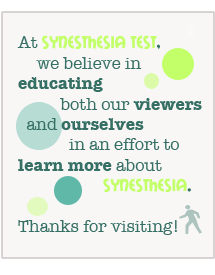Mirror-Touch Synesthesia: Pain & Empathy
 If you’ve ever accompanied a friend or family member on a doctor’s visit and sat in the very room the checkup ritual took place, you’ve likely had the fortune of empathizing with that friend or family member, watching as the stethoscope was pressed to the bare back, the reflex hammer hit the knee, or the vaccination needle penetrated flesh. Now, for a second (and no longer), imagine that, in watching these actions take place, you also felt them. A tingle on your back. A knock to your knee. A pinch on your skin. That is mirror-touch synesthesia.
If you’ve ever accompanied a friend or family member on a doctor’s visit and sat in the very room the checkup ritual took place, you’ve likely had the fortune of empathizing with that friend or family member, watching as the stethoscope was pressed to the bare back, the reflex hammer hit the knee, or the vaccination needle penetrated flesh. Now, for a second (and no longer), imagine that, in watching these actions take place, you also felt them. A tingle on your back. A knock to your knee. A pinch on your skin. That is mirror-touch synesthesia.
Synesthesia and Empathy
Think about the last time you watched someone take a bad fall or listened to a friend grind his or her teeth. For a split second, you cringe at the thought of physically feeling what they must feel. In a sense, we all empathize to some degree with the physical feelings of others. For an individual with mirror-touch synesthesia, however, the area of the brain that creates this empathy is hyperactive. These individuals don’t just cringe at the thought of comparable pain, but they might actually feel it themselves.
It’s an extraordinary thought, isn’t it? – your own sense of touch being activated by watching what’s happening to someone else. In this article from LiveScience, two mirror-touch synesthetes talk about their experiences and how this accentuated empathy has shaped their lives. I found Jane’s quote to be particularly interesting:
Another, Jane, said she felt her synesthesia is “a positive thing because I believe it makes me more considerate about the feelings of others.”
For non-synesthetes, like me, the best way to relate to this sentiment might be to think about pains or ailments we’ve suffered and how those experiences have shaped the way we empathize when others have similar misfortune. For instance: I’ve never broken a bone, so I’m not sure that I can truly empathize with someone who does. I just can’t be certain of what it feels like. On the other hand, I have had a pretty deep flesh cut – so when I observe someone accidentally cut themselves when chopping up lettuce, I can certainly empathize with the sting.
Are You a Mirror-Touch Synesthete?
While the answer to this question might be painfully obvious (pun fully intended), there are actually tests for this type of synesthesia. One of them, wherein a sensory interference task is used to verify the presence of mirror-touch, is described here (complete with a nice diagram). Another, which involves the user of fMRI, is discussed at length here.
Piggybacking off of the first test I linked, we might design a simple synesthesia test ourselves. You’ll need two friends to help you – one standing behind you and the other in front of you. On the count of three, have the friend that you can see place a finger on one cheek, both cheeks, or neither cheek. At the same time, have the friend behind you place a finger on one of your cheeks, both of your cheeks, or neither cheek. At the end of each trial, have the friend behind you record what you felt (left cheek, right cheek, both, or neither), along with what each of the two friends physically did. You can label them “visible friend” and “non-visible friend,” or something like that.
Repeat this process as many times as you’d like (try 50 or so to start), having your friends switch up their finger placements throughout the process. Once you have a nice collection of data, sit down and do some analysis. How many times did you feel that both cheeks were being touched when the visible friend was touching his or her right cheek and the non-visible friend was touching your left? Were there times when you felt that both cheeks were being touched, when in reality neither was? There are a range of possible combinations here, so it could get messy. Just something interesting to try on a rainy day!
That’s all for now, though. As always, we encourage you to share your mirror-touch experiences in the comments below! Catch ya later! 🙂
Interested in learning more about synesthesia? Subscribe to our monthly newsletter!
*Image from Time.com




